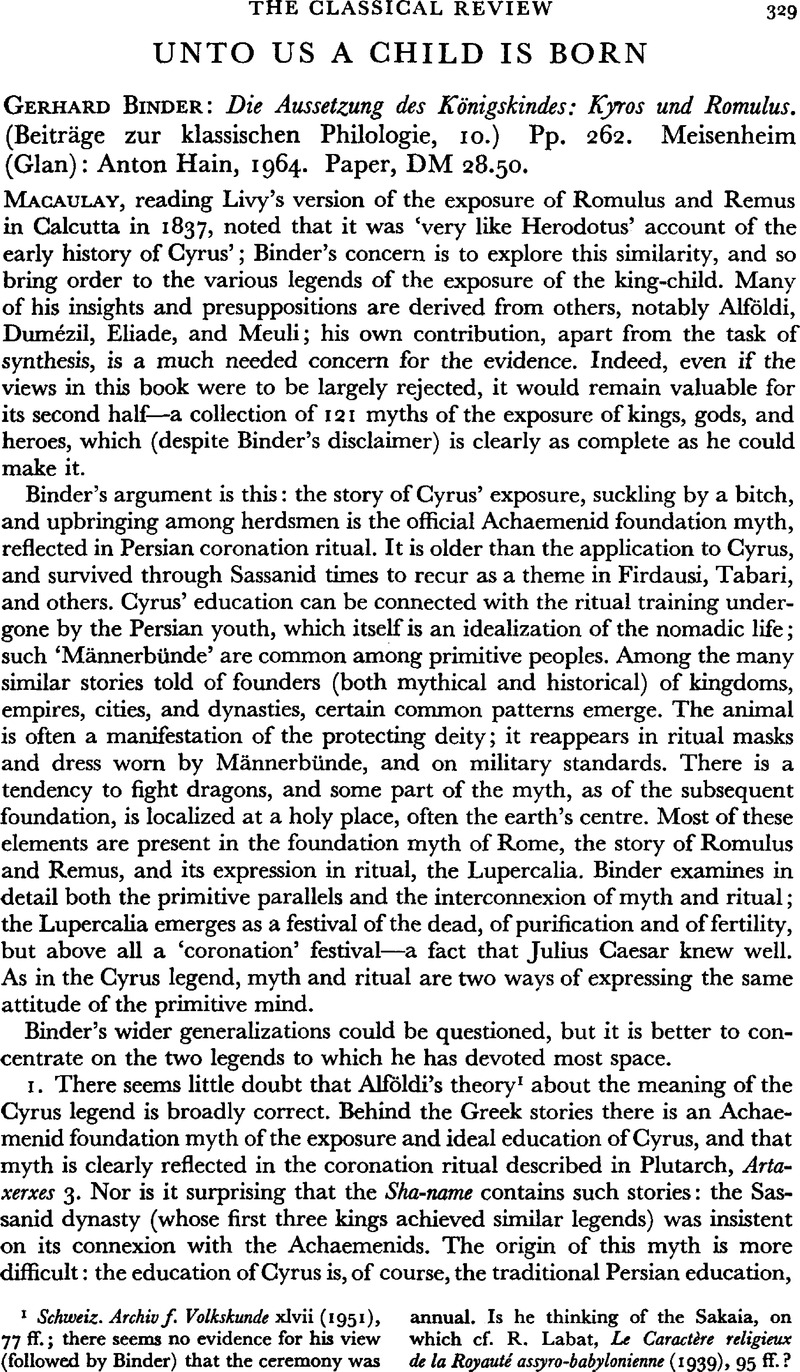Article contents
Unto us a Child is Born - Gerhard Binder: Die Aussetzung des Königskindes: Kyros und Romulus. (Beiträge. zur klassischen Philologie, 10.) Pp. 262. Meisenheim (Glan): Anton Hain, 1964. Paper, DM 28.50.
Published online by Cambridge University Press: 27 February 2009
Abstract

- Type
- Reviews
- Information
- Copyright
- Copyright © The Classical Association 1967
References
page 329 note 1 Schweiz. Archiv f. Volkskunde xlvii (1951), 77 ff.Google Scholar; there seems no evidence for his view (followed by Binder) that the ceremony was annual. Is he thinking of the Sakaia, on which cf. Labat, R., Le Caractère religieux de la Royauté assyro-babylonienne (1939), 95 ff.?Google Scholar
page 330 note 1 The text of the sargon story is seventh century, but its origins are obscure. It certainly reflects neo-Assyrian interest in Sargon as a founder, perhaps also a genuine Accadian myth, even historical fact: Labat, op. cit. 76 ff.; Widengren, G., The King and the Tree of Life in Ancient Near-Eastern Religion (1951), 15 ff.Google Scholar; Hirsch, H. E., Archiv f. Orientforschumg xx (1963), 5 ff.Google Scholar; Gadd, C. J., C.A.H. i2, c. xix (1963), fasc. 17. 3 ffGoogle Scholar. Compare Moses, and the story of Semiramis if it is really Assyrian.
page 330 note 2 Schmidt, E. F., Persepolis i (1953), pi. 114–117, 144–7, 195–6.Google Scholar
page 330 note 3 Cf. Kramer, S. N., Sumerian Mythology (1944), 76 ff.Google Scholar; for similar representations of Gilgamesh, Prinz, H., Altorientalische Symbolik (1915), 99 ff.Google Scholar; a winged lion e.g. in C.-F. Jean, Religion sumérienne (1931), pl.xv, 35.
page 330 note 4 With Persepolis i, pi. 147, cf. the Khorsabad relief of Gilgamesh and the lion-cub, with pi. 146 the Kuyunjik relief of Ashur banipal killing a lion. For the Royal Seal, see Sachs, A. J., Iraq xv (1953), 167 ffCrossRefGoogle Scholar. The sceptre and lotus flower held by Darius (Persepolis i, pl. 119–23 etc.) have a similar history as emblems of royalty: cf. Widengren, op. cit. 20 ff., esp. fig. 6; so too tiara and diadem.
page 330 note 5 He excludes exposure among commoners, both in reality and in literature.
page 330 note 6 He cites Suet. Nero 35 for the seriousness of king games, but not Dio, Or. 4. 47, Ael. Arist. Or. 26. 17 Keil for their use as literary topos.
page 330 note 7 Avesta yasht 10, 109–11; cf. I. Gershevitch, Avestan Hymn to Mithra (1959); but it could be claimed that the hymn merely reflects the situation after Zoroaster. For speculations about Mithras and kingship cf. Widengren, Hochgottglaube im alten Iran (1938), 146 ff.; Iranisch-semitische Kulturbegegnung in parthischer Zeit (1960), 62 ff.; Merkelbach, R., Numen vi (1959), 154 ffCrossRefGoogle Scholar. For Iranian kingship in general cf. Widen gren's résumé of his forthcoming book, La Royaulidé de I'Iran antique, in The Sacral Kingship (1959), 242 ff., and Die Religionen Irons (1965), 151 ff.; on whether the Achaemenids were Zoroastrians, ibid. 141 ff.
- 7
- Cited by




